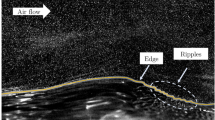Abstract
The problem of the optimal direction in which a flying or swimming animal should search for a chemical plume was addressed. Active spaces were approximated by sphere, prolate ellipsoids, or rectangular parallelepipeds of various length-to-width ratios. The optimum course direction for the sphere was in the direction of flow (downwind). For active spaces that were highly elongated along the direction of the wind or current, the optimal course heading (with respect to the moving medium) was nearly across the flow. For intermediate shapes, the optimal course was intermediate. Because of the effect of the moving medium, these course headings resulted in actual ground tracks that were more in the direction of the flow, depending on the relative speeds of flying (swimming) and the wind (current). When the two speeds were equal, the magnitude of the advantage of choosing the optimum direction over a random direction was close to 50% with a small dependence on the shape of the active space. If the active space was spherical or highly elongated or locomotor speed was much greater than the speed of the current, the advantage approached a factor of π/2 (≈ 1.57).
Similar content being viewed by others
References
Bossert, W.H., andWilson, E.O. 1963. The analysis of olfactory communication among animals.J. Theoret. Biol. 5:443–469.
Dusenbery, D.B. 1989. Ranging strategies.J. Theoret. Biol. 136:309–316.
Elkinton, J.S., andCardé, R.T. 1984. Odor dispersion, pp. 73–91,in W.J. Bell and R.T. Cardé (eds.). Chemical Ecology of Insects. Sinauer Associates. Sunderland, Massachusetts.
Gillies, M.T., andWilkes, T.J. 1974. Evidence for downwind flights by host-seeking mosquitoes.Nature 252:388–389.
Janzen, D.H. 1984. Two ways to be a tropical big moth: Santa Rosa saturniids and sphingids.Oxford Sun. Evol. Biol. 1:85–140.
Koopman, B.O. 1980. Search and Searching. Pergamon Press, New York.
Murlis, J. 1986. The structure of odour plumes, pp. 27–38,in T.L. Payne, M.C. Birch, and C.E.J. Kennedy (eds.). Mechanisms in Insect Olfaction. Clarendon, Oxford.
Nicholson, A.J., andBailey, V.A. 1935. The balance of animal populations. Part I.Proc. Zool. Soc. London 1935:551–598.
Pline, M., andDusenbery, D.B. 1987. Responses of the plant-parasitic nematodeMeloidogyne incognita to carbon dioxide determined by video camera-computer tracking.J. Chem. Ecol. 13:1617–1624.
Roberts, O.F.T. 1923. The theoretical scattering of smoke in a turbulent atmosphere.Proc. R. Soc. London, Ser. A 104:640–654.
Sabelis, M.W., andSchippers, P. 1984. Variable wind directions and anemotactic strategies of searching for an odour plume.Oecologia (Berlin) 63:225–228.
Tolmazin, D. 1985. Elements of Dynamic Oceanography. Alien & Unwin, Boston.
Wilson, E.O. 1970. Chemical communication within animal species, pp. 133–155,in E. Sondheimer and J.B. Simeone (eds.) Chemical Ecology. Academic Press, New York.
Author information
Authors and Affiliations
Rights and permissions
About this article
Cite this article
Dusenbery, D.B. Optimal search direction for an animal flying or swimming in a wind or current. J Chem Ecol 15, 2511–2519 (1989). https://doi.org/10.1007/BF01014727
Received:
Accepted:
Issue Date:
DOI: https://doi.org/10.1007/BF01014727




